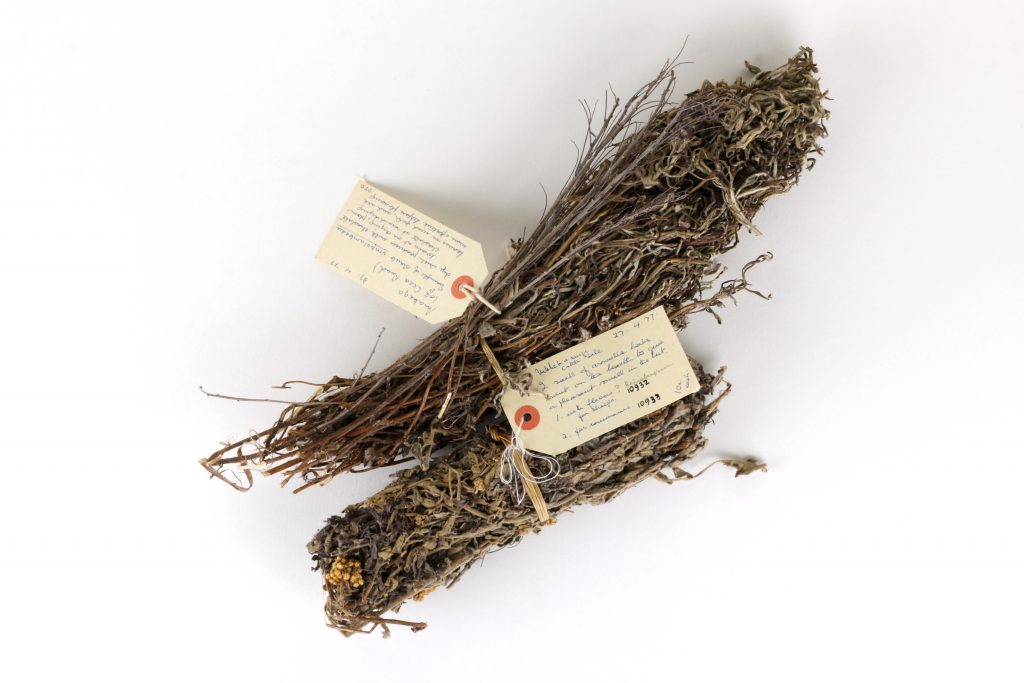
Listen to the pronunciation
| What is this? | Incense |
| isiZulu Name | Impepho |
| isiXhosa Name | Not yet documented. |
| English Name | Incense |
| Which cultural group created this? | Zulu |
| Who made this? | Not yet documented. |
| When was it made? | Not yet documented. |
| Where was it made? | Mahlabatini, KwaZulu-Natal |
| Measurements | Not yet documented. |
| How was it made and what is it made of? | Herbs bundled together with vegetal (?) twine. |
| What colour is it? | Different shades of green and yellow |
| What sound does it make? | Not yet documented. |
| Physical description | Two bundles of sweets herbs, tied together with twine (vegetal?). One of the bundles is longer than the other and they seem to be made of different herbs. Each bundle has a handwritten tag: Longer bundle: “27.4.77. Mabega (off Ceza Road). Sample of shrub umpelambedu dye which produces milk-chocolate brown at one dying, plain-chocolate at second dying leaves are used fresh, and are more effective before flowering. DTO” Shorter bundle: “27.4.77. Mushekamusi (?) cattle sale. 2 sarts (?) of aromatic herbs burn on the hearth to give a pleasant smell in the hut. 1. with flowers for chiefs. 10932 ? [?] 2. for [?] 10933 10 c. each.” |
| Where is it now? | Iziko Museum, Cape Town, South Africa Museum ID: SAM 10932 Accessioned on 27/04/19777 (donation) Store B26/m |
| How did it get there? | Bought to the South African Museum by EMS (seller at Mahlabatini says variety used by chiefs to scent the hut; bought roadside market 2km S of Ceza Hospital). |
| Why is it important? | Impepho (incense) is made with bush herbs found in tropical areas and is mainly used to connect with your ancestors, spiritual guides, and god. It is used in different ceremonies and cultural events (for example, when a family is doing a ceremony, they start by burning the incense to communicate with their ancestors). There are three types of incense, depending on the occasion and purpose. There is one that connects you with your ancestors and god. In most homesteads, one person takes care of burning the incense and communicate with their ancestors. That position is held by the elderly, the head of the family, or a specific person tasked with that duty. Women cannot be that person since they cannot talk to the ancestors or the god in ceremonies. When there is going to be a ceremonial celebration, they burn the incense to report what is going to happen. For example, when there is a wedding, they burn the incense twice. The first time to inform the wedding is happening, the second time when the ceremony is going to take place. On both occasions, the man joining the family burns the incense and express wishes for everything to go well. If the family were wealthy or had many goats, they would slaughter a goat every time they burnt the incense. The day before the ceremony, the family prepares Zulu beer, since beer should be part of the ancestors’ offering every time they burn the incense and slaughter the goat. People from outside the family and certain family members are not allowed in the hut during the burning of the incense. There is another type of incense called the twins’ incense. It is used to give thanks to the ancestors when you have twins because they are a special gift. There is another type of incense called inkondlwane. Incense can also be used to chase away bad spirits or if the children are crying at night (when you do not know why, you can burn the incense, so they inhale the fumes and fall sleep, and whatever is troubling them runs away). It can also be used for smoking or making tea. |
| Notes | Not yet. |
| References | Amagugu Ethu Workshop, Recording STE021, min. 34:31 to 36:31: Mbongeni Nomkhonwana, Thulisiwe Mtshali, Thulani Thusi, Skhumbuzo Miya and Thandi Nxumalo. Amagugu Ethu Workshop, Recording STE021, min. 48:29 to 49:53: Antonia Mekeila-Porter Amagugu Ethu Workshop, Recording STE01, min. 01:00:13 to 01:07:00: Nini Xulu Amagugu Ethu Workshop, Recording STE023: Boyzie Myeni, Skhumbuzo Miya and Thandi Nxumalo Amagugu Ethu Workshop, Recording STE031, min 05:33: Thandi Nxumalo Amagugu Ethu Workshop, Recording MVI4737, min. 03:50 to 07:05: Thulani Thusi, Thulisiwe Mtshali, Sikhumbuzo Miya, Hannah Turner, Boyzie Myeni and Thandi Nxumalo Iziko Museum Catalogue Card SAM 10932 |
| Who described this? | Described during the Amagugu Ethu Workshop by Mbongeni Nomkhonwana, Thulisiwe Mtshali, Thulani Thusi, Skhumbuzo Miya, Thandi Nxumalo, Antonia Mekeila-Porter, Nini Xulu, Boyzie Myeni, Skhumbuzo Miya and Hannah Turner. Described for the website by Clara Giménez-Delgado (August 24, 2020). |